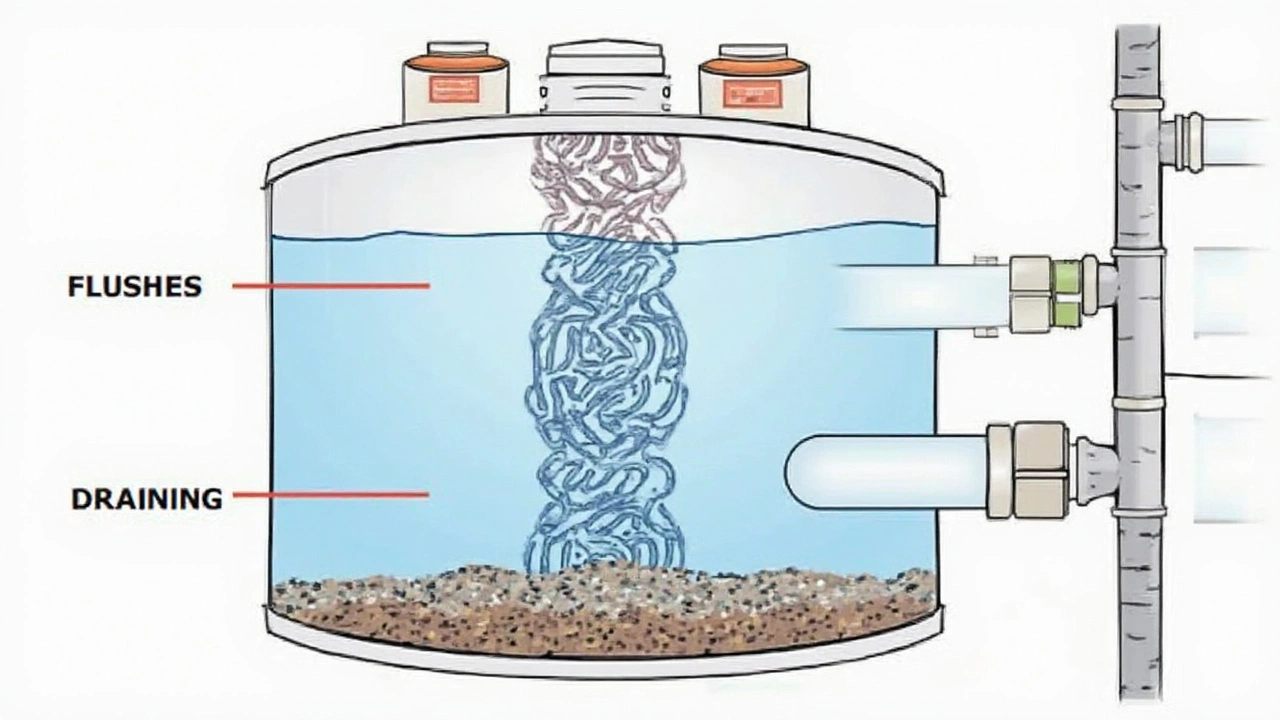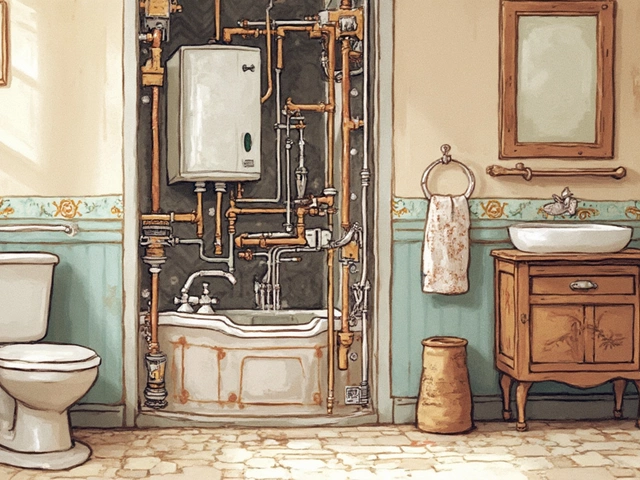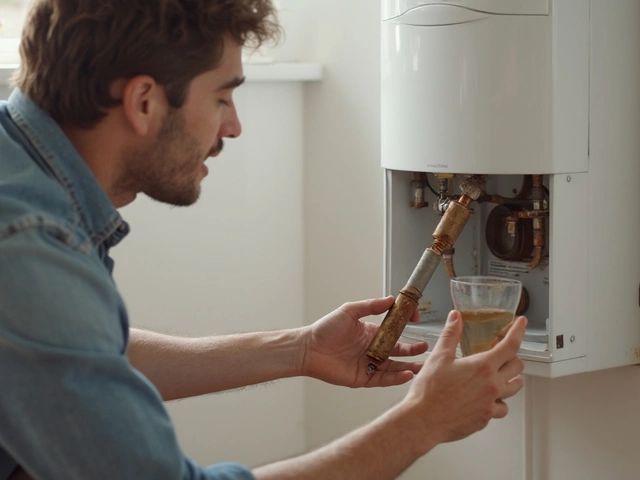Ever wonder if you actually need to flush your water heater—or if just draining it’s enough? It’s not just an argument for the hardware aisle. Letting sediment pile up in your tank makes your bills higher and can kill your heater way before its time. But here’s the thing: flushing and draining sound similar, yet they do really different jobs.
Most folks mix up ‘draining’ (which just empties water) and ‘flushing’ (which actually pushes out all that gritty sand, rust bits, and minerals that slowly build up at the bottom). You’d be surprised how quickly those little chunks start messing with your hot showers and heating bills. If you’ve ever noticed a weird noise like popping or rumbling, that’s not just the heater working hard—it’s that sediment baking on the tank.
- Flushing vs Draining: What's the Real Difference?
- When and Why: Timing Your Water Heater Maintenance
- Step-by-Step: How to Safely Flush or Drain
- What Most People Miss (and Smart Tips That Help)
Flushing vs Draining: What's the Real Difference?
If you’re like most people, water heater care probably falls somewhere between “I know I have to” and “how bad can it really get?” The words ‘flush’ and ‘drain’ get tossed around a lot—but they actually do different things. Let’s clear up the confusion.
Draining a water heater just means emptying it out through the drain valve. You turn off the water supply, open the valve, and let all the water flow out. That’s it. The main thing it does is get water out of the tank—maybe if you need to move the unit or do a repair. But here’s the kicker: draining alone doesn’t really get rid of the sand, bits of calcium, or other sediment that’s been building up at the bottom of the tank.
Flushing is where the magic happens for actual maintenance. Flushing uses fresh water (usually from your regular cold supply) to force those gritty bits and all the sludge out of the tank. This process stirs up all the gunk, then pushes it out the drain. It takes a bit longer, but it’s way more effective if you want to keep your water heater running smooth and not wasting energy.
Here’s a quick comparison:
| Method | Main Purpose | Effectiveness on Sediment |
|---|---|---|
| Draining | Empty tank water | Low – leaves most sediment behind |
| Flushing | Clear out water AND sediment | High – removes much more buildup |
If you see cloudy, rusty water coming from your hot tap or hear the tank making weird, popping noises, it’s a sure sign sediment’s hanging around. Just draining won’t solve it. For real maintenance, flushing is the way to go. Think of draining as “reset” and flushing as “deep clean.” Your heater will thank you in the form of fewer problems and lower bills.
When and Why: Timing Your Water Heater Maintenance
If you want your water heater to last and work right, the real secret is regular maintenance. Forgetting about it for years is honestly what kills most tanks. Flushing or draining once every 6 to 12 months is the sweet spot for most houses on city water. If you live somewhere with hard water, sticking closer to every 6 months is smart. Hard water means more minerals, which means more junk collecting in your tank faster.
The buildup from hard water isn’t just gross—it forms a stubborn layer that forces your heater to work overtime, which costs you more on energy and shortens the unit’s life. According to some utility studies, just a half-inch of sediment can eat up as much as 70% of your water heater’s efficiency. That’s the kind of thing you actually notice on your bills.
Here’s a helpful breakdown for timing:
- If your heater is brand new, start annual flushing right away. Don’t wait for sediment to show up.
- If you’ve moved into an older house and don’t know when the last flush happened, do it now. Then stick to a regular schedule.
- Homes with well water or especially hard water? Check sediment every 6 months. You’ll probably need to flush twice a year.
| Water Source | Recommended Maintenance |
|---|---|
| City Water (Soft) | Flush/Drain every 12 months |
| City Water (Hard) | Flush/Drain every 6-12 months |
| Well Water | Flush/Drain every 6 months |
Don’t wait for signs of trouble—like knocking sounds or lukewarm showers—because by then, that water heater is already working way too hard. A steady schedule keeps things hot, quick, and a whole lot cheaper in the long run.

Step-by-Step: How to Safely Flush or Drain
If you’re thinking about jumping into a quick water heater checkup, the way you drain or flush makes all the difference. Flushing isn’t just turning the tap and walking away. There’s a quick routine to keep things safe—and to make sure you actually get rid of the gunk.
- Turn off the power or gas. For electric heaters, switch off the power at the breaker. For gas, flip the thermostat to “pilot” or “off.” Never work on a live tank—it’s risky and burns happen fast.
- Shut off the cold water inlet. This slows the filling so you don’t make a mess when the tank drains out.
- Attach a garden hose to the drain valve near the bottom of the tank. Snake the hose to a floor drain or outside—hot water comes out, and it’ll wreck anything in its way.
- Pop open a nearby hot water faucet. That’ll break the vacuum and let the water actually flow. A closed system takes forever to empty.
- Now open the drain valve. If you’re only draining, just wait until the water’s out. If you’re flushing, after the tank’s empty, turn on the cold water supply for 1-2 minutes to stir up and blast out any leftover crud.
- Keep flushing until the water coming from the hose runs clear. Cloudy or gritty? Let it keep going. Most tanks with city water should clear up in about 5 minutes, but older or neglected tanks can take longer.
- Shut everything down. Close the drain valve, remove the hose, turn off the faucets, and only then turn the cold water back on. Once the tank’s full again, restore the power or relight the pilot for gas.
Pro tip: Don’t skip step 5—opening that hot water tap. So many people do, and then call the plumber because their tank won’t drain. And if your water heater is over 10 years old or never flushed, be gentle with the valves—they get brittle. If something seems stuck, don’t force it; you risk leaks or breaks.
| Average Sediment Removed | Frequency of Flushing |
|---|---|
| 1-2 cups | Yearly (city water) |
| More than 2 cups | Skipped flushing for 3+ years |
If you spot rust flakes or thick gunk, your tank might be overdue for replacement. But if the water runs clear, you’re set for another year of hot showers.
What Most People Miss (and Smart Tips That Help)
One huge thing homeowners skip is checking the state of their water heater anode rod. This small part actually takes the hit for the tank, attracting corrosion so the inside metal stays safe. If you’ve never swapped the anode rod, odds are it’s already gone. Replacing the rod every few years (about every 3-5 years on most tanks) could literally add years to your heater.
Want your flushing or draining to do more than just kill a Saturday afternoon? Here are a few overlooked tips you really want to know:
- Flush before problems show up: Wait for your heater to rumble, and you’ll likely never get all the sediment out. A good routine is once a year, or even every 8–12 months if you have hard water.
- Don’t ignore the drain valve: Some valves clog up from inside gunk. If yours stops flowing or leaks, swap it for a quality brass replacement. Plastic ones often fail early.
- Use the cold water trick: Blast in a burst of cold water during the flush to stir stubborn debris off the bottom. It’s an easy way to turbocharge sediment removal.
- Test the pressure relief valve: Lift the lever and let it snap back. If nothing happens or it dribbles, it’s time to replace it—this is a cheap safety move everyone forgets.
And here’s a stat that’ll hit home: according to a 2023 U.S. consumer report, heaters serviced every year with a full flush outlast neglected ones by 2–3 years on average. That’s a few hundred bucks—at least—staying in your pocket.
If you’re ever unsure, snap a quick picture of your heater’s model sticker before you start. Look up your manufacturer’s advice since some brands have unique flush instructions. It’s a quick check that can save you frustration (and maybe a warranty call) down the road.




